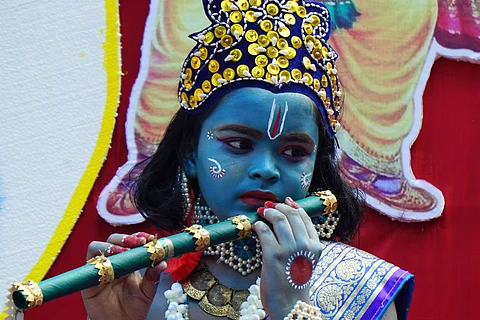
- Destinations
- Experiences
- Stay
- What's new
- Celebrating People
- Responsible Tourism
- CampaignsCampaigns
- Subscribe
- Buy Now

Janmashtami, also known as Gokulashtami, is one of the most vibrant and culturally significant festivals celebrated in India. It typically falls in August or September and marks the joyous occasion of Lord Krishna's birth. Lord Krishna is one of the most revered deities in the Hindu pantheon and is considered the eighth incarnation of Lord Vishnu. The celebrations surrounding Janmashtami are characterised by elaborate decorations, animated rituals, fervent prayer sessions, and a unique practice known as "dahi handi," where participants form human pyramids to reach and break an earthen pot filled with curd, symbolising a legendary episode from Krishna's childhood.
If you wish to immerse yourself in the vibrant tapestry of Hindu culture during Janmashtami 2025, here are 6 places in India to witness the celebrations and make the most of your vacation.
Mathura, known as the birthplace of Lord Krishna, is a prominent destination for Janmashtami celebrations. The city comes alive with enthusiasm during this festival. The festivities in Mathura are divided into two parts: Jhulanotsav and Ghatas. Jhulanotsav involves setting up swings in homes for Krishna idols, bathing the idols with milk, curd, honey, and ghee during the Abhishek ceremony, and placing them on swings for celebration. Ghatas involves the decoration of all the temples in the city with a uniform color scheme and various puja rituals to mark the moment of Krishna's birth. Mathura boasts some of the most renowned Krishna temples in the world, including the Bankey Bihari Temple, Dwarkadhish Temple, Krishna Janmabhoomi Mandir, and the ISKCON Temple. You can also enjoy the Raas Leela, a dance drama performance that depicts various phases of Krishna's life.
Vrindavan, located around 15 km from Mathura, is another significant place associated with Lord Krishna. It is believed to be where Krishna grew up and performed his famous raas leela with Radha and the gopis. Janmashtami celebrations in Vrindavan begin ten days before Krishna's birthday. Like Mathura, raas leelas are performed all over Vrindavan, and temples are adorned with colourful decorations. The Govind Dev temple in Vrindavan is one of the oldest shrines in India and a must-visit for Krishna devotees. Nidhi Van, a sacred Krishna temple amid a dense forest, is another place of interest. Vrindavan is home to over 4000 temples, including Ranganathji Temple, Radharaman Temple, and the ISKCON Temple, all of which enthusiastically celebrate Janmashtami.
Gokul was where Krishna was taken immediately after his birth in Mathura. Krishna grew up here under the care of his adopted parents, Yashodha and Nanda, making it an essential place associated with his childhood. Janmashtami, also known as Gokulashtami here, is celebrated one day after the rest of the country. Gokul residents celebrate Dadhikana or Nandotsava, during which people drench each other with curd and turmeric to celebrate their joy. Prominent temples in Gokul include the Radha Raman temple and Radha Damhodar, where Janmashtami celebrations feature rituals, chanting of mantras, and the bathing of the Krishna idol with curd, buttermilk, and nectar.
Dwarka is a city with great religious significance. It was Krishna's kingdom for around five thousand years after he left Mathura. Janmashtami celebrations in Dwarka are famous and attract devotees from all over India. During Shravana, the Aboti Brahmins of Dwarka perform daily Janmashtami pooja called "nitya kram." The celebrations include "mangla aarti," rituals at temples, bhajans, garba events, and raas dances. The five-story Dwarkadish temple is a prominent attraction, with its stunning architecture, 60 carved columns, and a spire that towers above the city. The Rukmini temple, dedicated to Krishna's wife Rukmini, is another place worth visiting.
Mumbai, known for its bustling nightlife, Bollywood, and cosmopolitan culture, also celebrates Janmashtami with grandeur. The city is home to an active "dahi handi" culture, where various groups called Govinda mandals participate in events held throughout the city. This tradition involves forming human pyramids to reach and break an earthen pot tied high in the air. Mumbai's dahi handi celebrations have become a significant business affair involving sponsors, politicians, and tourists. Some of the best dahi handi celebrations occur in Worli, Thane, and Jogeshwari areas.
Udupi, a city in Karnataka, is famous for its Krishna temple and its unique Udupi cuisine. The Sri Krishna Mutt in Udupi is believed to have been formed after Dwarka submerged underwater. Janmashtami is celebrated in Udupi with great artistic and cultural finesse. Street performers showcase versions of the famous raas leela through folk singing, dancing, and skits. Local meals like "kottige" or "gunda," which are idlis steamed in jackfruit leaves, are prepared during Janmashtami. Clay idols of baby Krishna are taken around the city in a procession accompanied by devotees.
Q1: When is Janmashtami 2025?
Janmashtami 2025 will be celebrated on Saturday, August 16, marking the birth of Lord Krishna, followed by Dahi Handi festivities the next day in many regions.
Q2: Which is the best place to celebrate Janmashtami in India?
Mathura, Krishna’s birthplace, is considered the most iconic destination, with grand processions, temple rituals, and Raas Leela performances.
Q3: Why is Vrindavan famous for Janmashtami?
Vrindavan is believed to be where Krishna spent his childhood. The city hosts vibrant temple decorations, Raas Leelas, and special pujas during Janmashtami.
Q4: Can tourists participate in Janmashtami celebrations?
Yes, visitors are welcome to join temple festivities, watch cultural performances, and explore decorated streets, though it’s best to follow local customs.
Q5: Are Janmashtami celebrations the same across India?
No, celebrations vary by region — from Dahi Handi in Maharashtra to temple rituals in Uttar Pradesh and devotional singing in Gujarat.
